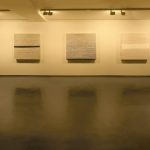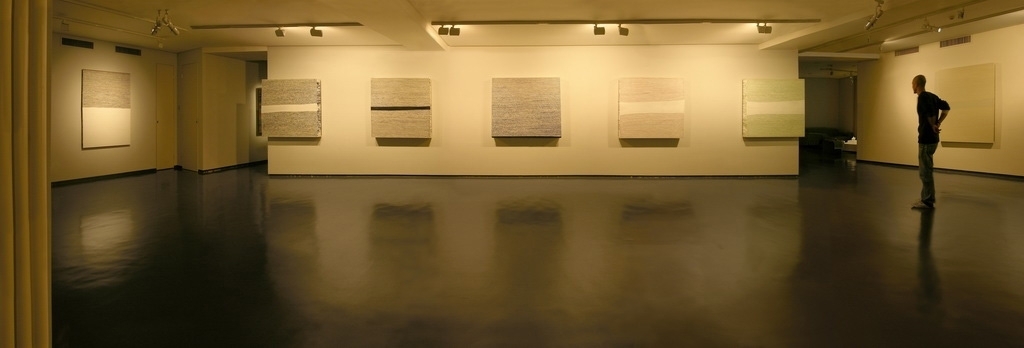Coffin Paint
2007.11.30 – 2008.01.30
Press Release
Coffin Paint————growth ring born to die By Tian Kai
In 1998, Wang Guangle carrying some necessities with the bicycle, moved to Dong Xin Dian, the northeast of Beijing, from the student’s dormitory in Central Academy of Fine Arts. This is a typical interurban area, an ulcer region of the city, rent to the farmers, laborers from other places, taxi drivers and people unemployed. Guangle resided here with them, living in the rental farmer’s house, started his independent life and the creation.
In Dong Xin Dian, Guangle painted the series “3pm to 5pm” which is his graduation work in the CAFA. This series expresses accurately the lazy time and space in the afternoon in the CAFA. I think, each graduate from the CAFA would have the sincere recollection about the “Er Chang” period, also would have the sympathy to Guangle’s work. The sunlight outside the window shoots from the heavy curtain onto the ground of assembly hall, the boundary of the light is warm and disordered, reducing one layer upon layer to the dark ground, to form the center in the interesting of the picture. Henceforth, Guangle is infatuated with the performance by light. I guess that, it’s perhaps the innumerable boring afternoons, the long time gaze upon the studio’s terrazzo ground in Dong Xin Dian, has brought up the “Terrazzo” series. In several early “Terrazzo” paintings, the afternoon light shines on the terrazzo floor, the light spots are different, rectangle, linear, every tiny stone shinning under the sunlight is also different, Guangle describes them with completely practical technique, he even paints the effect as watermarking. That time, Guangle was still immersed in the convenience and joyfulness of the straight description from the practical teaching in NO.1 Studio. But there, the light, was no longer the light in the impressionist paintings, but is the light to the spiritual way. While Guangle makes effort averagely in each tiny stone to paint ten thousands of tiny stones tirelessly, a kind of simple ultimate concern has already ambushed in Guangle’s painting.
Whatever the “3pm to 5pm” or “Terrazzo”, even the “Hou Hai” series which he selected material for from the landlord’s old pictures, all contain an important factor – – time. In these works, as a result of most simplification processing of color, all the characteristics of the assembly hall, the terrazzo floor and the characters as objective things were eliminated as far as possible, as if only the light left. This just agrees with the time expression in Chinese – – days and time. As for the expression object, the two hours between 3 pm to 5pm, are precisely the subjects Guangle attempts to express, that two hours in several dozens afternoons, are embodied in the picture, depending on the light, to become the lead. This is abstract. But the terrazzo, is a sort of building material which let’s feel the time intuitively. It is mixed pebble with the cement, after making the ground level, just left to be polished for long time. If to use handwork, it will consume longer. Guangle is duplicating the manufacture process of this kind of material quality nearly by painting. The innumerable silent afternoons and nights in Dong Xin Dian, the accompany is only the time passing, nothing happens, if there’s some background music, revealing to the picture, is also the monosyllable note, unable to form the rhythm. In 2005, Guangle painted “Terrazzo” on an entire wall in the big house which would be demolished. Along with bulldozer’s destroying, this work could be completed – – what the bulldozer destroyed is not a wall, but three month-long time. The time may be destroyed and negated. Regarding “time” this abstract concept, it is a vivid expression with black humor, even if that behavior has moving and tragic color. Guangle then collected some surviving terrazzo pieces, congealed them with gypsum, to form a section of “time relic”.
Also in 2005, Guangle’s “Terrazzo” started to strip the light, and no longer pestered in the objective details, to become the form similar as calligraphy and as abstract, but way of painting with “making effort averagely” was retained. There’s no center on the image, no beginning and ending. Some works were completed just by once, the gravels were not the gravels, much more like characters, using the brush pen with the calligraphy center, between carrying and turning, with dense and numerous outlines. I asked him, what he was thinking when he’s painting like that? He said anything had been thought, and some time just nothing, but it could not be seen the painter’s mood completely on the picture, like monks and priests read the religious texts every day. This period of creation is an important transition.
During the period of creating “Terrazzo” series, Guangle started painting “N Tins of Acrylic Paints”, which is to apply various colors of acrylic paints in parallel on the canvas, there’s too many times with new covers above old ones to form the effect as drips on the edge of canvas, the picture is thick and the color is gorgeous. This group of work let me associate the Color Field Painting in the 1960s, especially the work by Barnett Newman, so I did not approve at the beginning, and Guangle also simply explained as, it took too long time painting terrazzo with single color and felt too constrained to select the colorful paint, and that’s really. In afterwards conversation, I knew this kind of “painted to his heart’s content” comes from Guangle’s memory about childhood. On his hometown, the Songsi area in Fujian, old people paint their own coffin, paint once every year, then after it dried, if next year he’s still living, he will paint once more. I know that feeling, to paint raw lacquer once by once on the wooden article with the background completed, can feel an inexplicable joy. Because the raw lacquer is not easy to be well controlled the humidity and dryness, therefore it is very difficult to paint evenly without any flaw, also absolutely need to be patient. But even if an ordinary little thing, the finally completed lacquer ware would bring long-time feeling of satisfaction to any perfectionist. The traditional raw lacquer craft is preserving in many local places in Fujian, that is an ancient craftsmanship spreading from the Warring States time until now, aristocrats of Han Dynasty also let the artisan prepare exquisitely made bury implement before their death. However, while living from 60 year old of start the old people paint their own coffin, by themselves, this custom lets feel somewhat sighed. If an old man lives to 80 years old, he might paint the coffin every year during the period of 20 years, paint every time as attractive as possible, to the last years of life, the point of death, he would be satisfied to wait the funeral with the coffin painted with shining lacquer all over the body. Or it could be, , the old man just has been covered under the shadow of death every year from 60 year old of start? We rather believe the former. Actually, this custom expresses that the old people understand the death in another way, to be aware the ultimate significance of life by other people’s birth and death. Death is not the opposition of birth, but is a part of it. Guangle said, in childhood his grandfather painted joyfully for his own coffin, which has given him very deep impression. This custom have no name, Guangle calls it “coffin paint”. Facing the possible remote death, in the time impossible to forecast, the process of coffin paint is not only a common preparation, but also the spiritual preparation of “born to die”.
After 2006, the custom from far distant hometown influenced deeply on Guangle’s creation. He started to reduce the color factor in the series “N Tins of Acrylic Paints” to the least, so many colorful stripes can not play the role to separate the area, but to show the layers of acrylic paints, and color is actually not the theme this series need to express. Here, the theme is only one: to cover, and cover again. Only using two type of color to brush strips, a strip covers another. Guangle even directly changed this series name as “Coffin Paint”. There are lots of many layers of acrylic paints covering evenly on the canvas, on edge of the work, the heaps of paints form the thick and heavy sense of quality and varvity as rhinoceros horns, no boundary on the picture, with the feeling like sculpture and the extraordinary integrity. In one work all over the black, because of the different drying velocity on the superficial and the interior, the thick acrylic paints get up the folds in the middle part, sending out a corrugated bright. This is extremely like the effect as patent leather. In another group of works, Guangle only used a type of extremely pale warm gray to paint evenly towards the center of the picture from all around, more toward the center, more times to paint, just like trees’ growth ring, more near the center, the color being deeper. The simple technique and the sole color, is unable essentially to form the image, but the color which is too pale to be perceived overlays innumerably, can achieve a kind of depth which is not only the depth of color, but the depth of longitudinal force in spaces, the sense of light diffuses in everywhere on the picture, lets think of the Taoism’s narration about how the universe produced: The Tao produced One; One produced Two; Two produced Three, Three produced All things.
Guangle diverted the way of “coffin paint”, transplanting it on the canvas, under the limit of square frame, the purest technique and color has unexpectedly formed the enormous tension. On the image, the fortuitousness made of acrylic paints used repeatedly becomes the control to picture. This interest is also the main part which Guangle pursues on painting. Same as the “Terrazzo”, “Coffin Paint” series is also a complicated practical training. But it moved towards three-dimension from two dimensions, and turned the coverage from the arrangement. The texture of rhinoceros horn and the growth ring of trees are all the products by time. The acrylic paints are brushed by several hundred times, also became similarly the indication referring the time.
In cities, people intense upward, just like already forget the matter about death which would never gone. It seems to consider the death earlier is the matter with philosophers. Facing directly the ultimate significance of life and the oncoming of death, let us be tranquil and far away flighty and rash. I think this is also the metaphor from the “Coffin Paint” beyond the picture.


